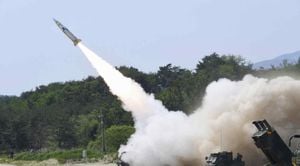Delhi is currently grappling with what many are deeming its worst air pollution crisis to date. For the second consecutive day, the capital's air quality has been categorized as "severe plus," prompting serious health advisories from officials. Schools have closed their doors, and vehicle access has been limited. The Supreme Court has even weighed in, urging residents to wear masks as PM2.5 levels surged alarmingly high, reaching nearly 17 times above the recommended limit set by the World Health Organization (WHO), which is just 25 micrograms per cubic meter.
This week, the air quality monitoring systems reflected appalling figures, with readings showing PM2.5 concentrations hitting 420 micrograms per cubic meter, resulting from unfavorable weather conditions and continual pollution from burning stubble and other sources. The rapid decline of air quality is not just seasonal; it's symptomatic of systemic challenges the city faces. While the immediate culprits are clear—industrial emissions, construction activities, and agricultural stubble burning—the roots of the issue dig deep.
At the heart of the problem lies the perennial challenge of air pollution, which spikes each autumn due to the confluence of several adverse environmental conditions. Farmers, especially those from neighboring states like Haryana and Punjab, are often blamed for their stubble-burning practices, which add to the toxic brew of air quality woes. Interestingly, the practice itself is driven by national agricultural policies which have changed the timing of rice harvesting, putting farmers under pressure to clear their fields quickly. This pressure contributes significantly to Delhi's pollution spikes each year.
State governments have attempted to monitor and control stubble burning through satellite imaging and regulations, but reports suggest this has been largely unsuccessful. Farmers are said to have adapted their methods to avoid detection by setting fires after the satellite monitoring passes. Experts argue for improved satellite technology to provide on-the-ground solutions, expounding on how existing systems fail to capture the widespread practice effectively.
The situation has spurred voices like Aarti Khosla from Climate Trends, who emphasized the need for actionable change—not just finger-pointing at rural farmers. The reality is complicated; agricultural burning accounts for about 40% of the pollution during peak periods, and as Khosla explained at the recent COP29 climate discussions, it’s foundational to address both the urban emissions and agricultural practices year-round.
Further complicity arose as studies indicated the adverse health effects of this sustained pollution. Children, particularly those living within urban areas, suffer disproportionately. Enkhun Byambadorj, co-founder of Breathe Mongolia, warned during a panel discussion at COP29, stating, "Children in cities have 40% lower lung capacity compared to those in rural areas,” exemplifying the long-term detrimental effects urban air pollution has on the younger population.
At COP29, attention on Delhi intensified, pushing global experts to rally for aggressive, science-driven strategies to combat pollution. Specific recommendations included actionable policies targeting emissions from local industries, enhanced public transport to reduce vehicular emissions, and sustainable agricultural practices rooted not only in local economies but also fostering health benefits.
While short-term measures are being enforced—including online classes for students and work-from-home policies for some government employees—the long-term strategy is still developing. Critics highlight the ineffectiveness of these hasty regulations, and as one expert aptly put it, "Air pollution is not just the winter’s problem; it’s the year-round battle we must face.”
Databases from the WHO note Southeast Asia consistently suffers from some of the world's highest pollution levels, with air quality emergencies becoming commonplace. Delhi's crisis extends beyond its own city limits, affecting vast areas of the Indo-Gangetic plain, where shared air quality issues require coordinated regional responses.
Notably, calls have emerged from within the global community for integrated management of air quality spanning across national borders, recognizing how health and climate challenges intermingle. There’s acknowledgment of the notion termed as the "triple win"—reducing air pollution, combating climate change, and fostering economic development through green technologies.
The grim irony remains how airborne particulates stemming from coal-burning and stubble fires directly correspond with increasing rates of heart disease, lung cancer, and breathing disorders. Health professionals from several global organizations at COP29 spotlighted the need for urgent healthcare funding. According to Dr. Courtney Howard from the Global Climate and Health Alliance, the detrimental impacts of pollution manifest very rapidly, requiring immediate intervention: "When air pollution levels skyrocket, emergency departments are flooded with patients suffering from respiratory illnesses and other health crises exacerbated by these dire levels.”
Observations made at the conference strengthened the call for greater funding directed not just at combating climate change but also for enhancing public health systems to help populations like those affected by Delhi’s pollution emergency. Howard highlighted the glaring disparity between subsidies for fossil fuel industries and investments directed toward public health, urging policymakers to realign these financial priorities.
Delhi’s pollution crisis is not merely confined to the immediate city. The environmental fallout extends across northern India, affecting states like Uttar Pradesh, Haryana, and Punjab, beckoning swift action from local, state, and national powers. The potential solutions are as diversified as the sources of pollution; advocating for regional cooperation, emphasizing sustainable practices, enhancing surveillance and penalties for polluters, coupled with greater subsidies for clean agricultural practices, is integral to enacting meaningful change.
Amid this disarray, awareness and activism may subtly shift the narrative. It requires collective participation from citizens, cities, and global actors to reevaluate resource frameworks concerning air quality management, fundamentally reconsidering choices made by society prioritizing health over convenience and profit.
When we look at the alarming state of affairs surrounding air quality, it becomes clear—we’re at the juncture of societal accountability and ecological responsibility. The stairway to cleaner air is laden with policy reform, technological advancement, and fundamental shifts in how we regard pollution on every level—from local farming practices to international climate accords.
The air we breathe dictates the health we experience. The call for action rings louder than ever as the narrative shifts at events like COP29, holding nations accountable for their air quality, steering the spotlight on solutions as vast as the problem persists. The time for transformative and collective action is now—both to save the children of today and to protect the environmental legacy for generations yet unborn.
There's no sugarcoated way to frame the situation; Delhi’s pollution levels demand urgent, cohesive efforts among nations. The time for talk has passed—what we need now is action. The global community must unite and work together, tackling the intertwined crises of public health and environmental degradation. No more ignoring the elephant in the room; it’s time to breathe life back.



